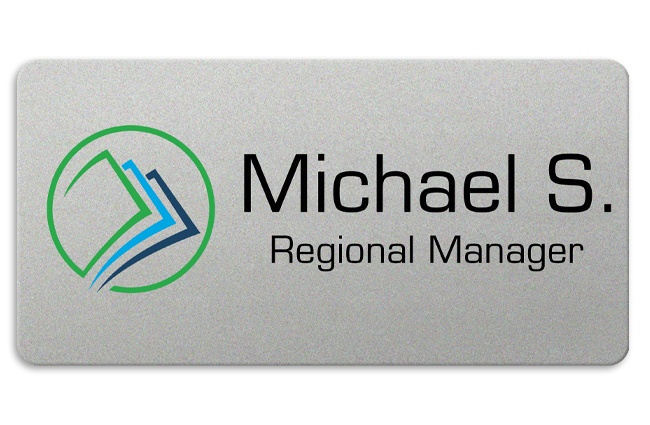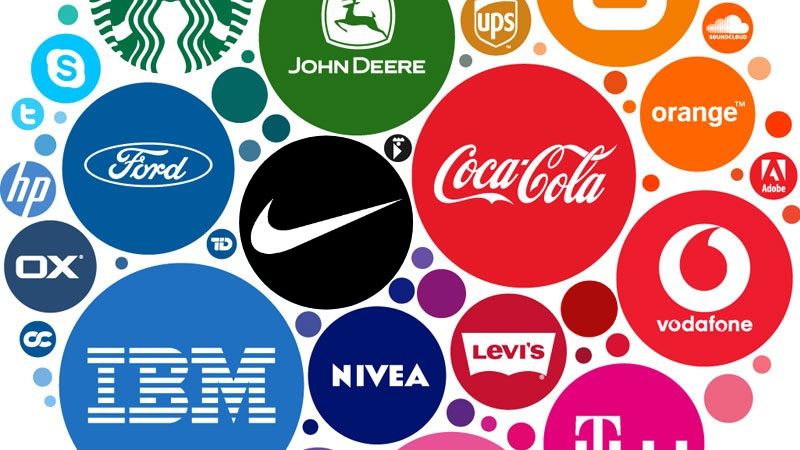(and Customer Relationships)
The phrases corporate identity and brand identity are thrown around abundantly by everyone in business. However, when used it different contexts, they mean different things. It’s often asked if you can have a brand identity without a corporate one, or vice versa. Here are several reasons why you can’t have one without the other.
But, first things first, what are the differences between corporate identity and brand identity?
Brand Identity
Brand identity
refers to the how consumers view a specific product, service or idea
a business provides. The goal in creating your brand identity is to
separate your business from similar businesses. So, basically, brand
identity is the customer’s knowledge of and ability to recognize
the brand.
Our Example: Name
Tag, Inc. sells personal identification such as name tags and other
custom engraved products.
Corporate Identity
Corporate identity
is similar to brand identity. However, corporate identity refers to
the perception of an entire company, not just one idea, product or
service that the company provides. One business may have many
different brand identities wrapped up in its overall corporate
identity.
Our Example:
Coller Industries Incorporated is also known as Name Tag, Inc. and
Personalized Ribbons.
Let’s talk about branding your business for a
moment.
A company’s brand is what they are, what they want to be, and what they aim to become as a whole. It can be a promise of quality, trust or service. A brand is what makes a company or organization truly unique. Branding should make any company stand out from its competitors and lets the consumer know what to expect from that company.
Branding is one of
the most important parts of any business, whether it be large or
small. Building a strong brand helps a company or organization be
financially strong. Product marketing is really where this process
all begins.
Let’s break it down a bit farther to make it a little easier. The act of branding is the process involved in creating a unique name or image for a product, person or idea. This is done mostly through advertising and other similar means. It is also the action of building a convincing individual or unique presence in a consumer market that attracts and retains loyal customers.
Corporate branding is the process of promoting the logo and/or brand name of a company or corporation for marketing and advertising purposes. Typically the range of a corporate brand is very broad and is often used as a way to express the company’s ideals and goals.
A BRAND IDENTITY IS WHAT MAKES A BUSINESS UNIQUE.
It’s what they think, how they behave and what they believe in. It’s about how they treat their employees and customers. So, brand identity is a must for every business. The better a business understands itself, the better they will perform and the more their brand identity will show their power and values. Once this is accomplished, a business will preform more effectively. When a brand identity is clear, values and business practices just fall into place. Teams are formed and decisions become easier. And, the company stays focused on marketing and sales goals.
Brand identity is…
…the collection of all elements that a company creates to portray the right image to its consumer. Brand identity is different from “brand image” and “branding,” even though these terms are sometimes treated as interchangeable.
The term branding refers to the marketing practice of actively shaping a distinctive brand. Brand is the perception of the company in the eyes of the world. Those tangible elements, that’s brand identity.
Your brand identity is what makes you instantly recognizable to your customers. An audience will associate your brand identity with your product or service, and that identity is what forges the connection between you and your customers, builds customer loyalty, and determines how your customers will perceive your brand.
Design assets are the tangible elements that will determine how your brand is perceived. Things like your logo, your packaging, your web design, your social media graphics, your business cards and the uniforms your employees wear.
Your brand identity is what sets you apart from the endless sea of competitors and shows your customers who you are and what they can expect from working with you. And if you want your brand to be perceived in a positive light, it’s crucial that you nail your brand identity and create designs that accurately portray who you are to your customers. And now that you know how to nail that identity, it’s time to start designing.
“What is brand identity? And how to develop a great one.” by Deanna deBara
Brand identity is…
…the total proposition that a company makes to consumers – the promise it makes. (Brand identity) may consist of features and attributes, benefits, performance, quality, service support, and the values that the brand possesses. The brand can be viewed as a product, a personality, a set of values, and a position it occupies in people’s minds. Brand identity is everything the company wants the brand to be seen as.
Brand image, on the other hand, is the totality of consumer perceptions about the brand, or how they see it, which may not coincide with the brand identity. Companies have to work hard on the consumer experience to make sure that what customers see and think is what they want them to.
Simon Morris, LinkedIn Pulse: “What’s the difference between corporate identity and brand image?”
Your corporate identity is so much more than just design.
Yes, your logo and brand play an important part in your corporate identity. But, remember that you are so much more than a color or style. A company’s values and culture are crucial in shaping corporate identity. As Simon Sinek, author of Start with Why: How Great Leaders Inspire Everyone to Take Action has said, “people don’t buy what you do; they buy why you do it. And what you do simply proves what you believe.”
It is important to distinguish between corporate identity, brand identity, and brand image. Corporate identity is concerned with the visual aspects of a company’s presence. When companies undertake corporate identity exercises, they are usually modernizing their visual image in terms of logo, design, and collaterals. Such efforts do not normally entail a change in brand values so that the heart of the brand remains the same – what it stands for, or its personality. Unfortunately, many companies do not realize this fallacy, as they are sometimes led to believe by agencies and consultancy companies that the visual changes will change the brand image. But changes to logos, signage, and even outlet design do not always change consumer perceptions of quality, service, and the intangible associations that come to the fore when the brand name is seen or heard.
Simon Morris, LinkedIn Pulse: “What’s the difference between corporate identity and brand image?”
The Importance of a Corporate Identity
Corporate
identity expresses your brand personality and tells the world why you
are unique. Similar to what makes a person unique, this identity
shows what is specific to a business. These specifics set us apart
from others and helps us to build relationships within our
communities. This aspect works for businesses as well. How a company
presents themselves in everything they do, from business cards to
products or services they offer, is what defines this identity.
It is a physical expression of the company’s brand, an extension of the culture that is already expressed through communication style and behavior exhibited to maintain the image of the business. Corporate identity and brand identity both have different roles, that together, form a perceived image for a business. It all starts with your reason for going to work every day and why anyone else should care.
“How to build a strong corporate identity” by Anna Lundberg
Occasionally,
a business may need to update their corporate identity if their
audience changes. From logos to letterhead, rebranding is often done
in the business world. Invest in this identity to develop your
customer’s trust, a sense of product value and a lasting connection
with your clientele.
Your
corporate identity helps you in increasing business ownership and
control. As consumers are now aware of your business, they can
understand your company’s image and reputation. You then have to
continue to provide your quality services or products to your clients
exactly as you developed them for your corporate identity to continue
to succeed.
A logo is not your brand, nor is it your corporate identity.
Many business owners believe that by simply having a recognizable logo, their quality and values are represented. But, having a strong corporate identity helps out in every aspect of business. Don’t underestimate the importance and power of developing this identity for your business. It will help you grow in your competitive market. And, you will be able to leave a positive vision for your consumers as your identity grows.
A strong corporate identity is essential for every business organization as it helps in the interaction of the customers and the company. Customers usually get a great help in understanding the business with the help of its corporate identity. It includes the several supporting devices, such as the company letterhead, business cards, website etc. It creates a single and clear visual identity for an organization. A number of Start-Up companies ignore the advice of building or developing a strong and effective corporate identity for their business as they think it just as the logo only.
While we have been talking about corporate and brand identities, don’t forget that the end goal is to build your customer relationship. Managing a consumer relationship is an important approach to making sure a company’s interaction with current and potential customers is fresh and positive. You will be able to retain current customers and build new relationships when you bring your corporate identity in line with this endgame.
Always
look for ways to wow your consumers. Whether that means compromise on
a service or providing the highest quality product, remember that
without your customers, your business would not prosper.
Customer Relationships
While we have been
talking about corporate and brand identities, don’t forget that the
end goal is to build your consumer relationship. Managing a consumer
relationship is an important approach to making sure a company’s
interaction with current and potential customers is fresh and
positive. You will be able to retain current customers and build new
relationships when you bring your corporate identity in line with
this endgame.
Always look for ways
to wow your consumers. Whether that means compromise on a service or
providing the highest quality product, remember that without your
customers, your business would not prosper.
To create customer relationships, and keep them strong, you must do all you can to engage customers. Here are five ways to build customer relationships and keep them coming back.
1. Communicate.
As a key to any good
relationship, communication is an essential way to build customer
relationships. Promoting your business and listening to your
customers are equally important.
Rather than just
telling customers about your business, have conversations with them.
Find out what your customers need, then show them that you have a
solution to their problem.
If you have
employees, teach them how to effectively communicate with customers.
Instead of waiting for customer service to become a problem, foster
communication skills with customers while onboarding new employees.
Maintain an employee policy, requiring timely follow-up, to make sure
the customer’s needs are met. Make sure your staff returns
voicemail messages and emails promptly.
2. Exceed expectations.
Your customers
expect great products or services from you. You should continue to
raise the bar on what your company offers.
To put it simply,
under promise, and over deliver. When you impress customers, they
keep coming back.
To exceed customer
expectations, you can deliver a product or service faster than
anticipated. When you deliver earlier than expected, the customer
will be happy about the surprise. For example, tell a customer their
order will be ready by the end of the month, knowing you will have it
ready a week earlier.
3. Ask for feedback.
Whether customers
have a good or bad opinion about your business, they will make their
feelings known. Invite customer feedback to show you are listening.
Place comment cards on your business counter, or conduct a survey.
Customer feedback
helps you hone your customers’ specific needs so you can find the
best solutions to their problems. The better your offering meets
their needs, the more your business will grow.
Always listen
carefully to comments and respond promptly, whether it’s a
compliment or a complaint. The worst thing you can do is ask for
feedback then not address concerns. Even negative feedback is
valuable and can give you an honest gauge of customer satisfaction.
4. Connect.
With technology,
there are more ways to begin conversations with your customers than
ever before. There are many online tools and social media outlets you
can use to reach customers.
When you engage with
customers online, be careful not to create a one-way conversation.
Ask customers questions, and respond to their inquiries.
Also, make sure your
website is top-notch, and start a blog to engage your customers and
prospects. Build customer relationships through your online presence.
5. Show appreciation.
Reward long-time
customers with a loyalty discount program. You can hand out reward
cards, or use a loyalty program app to track customer rewards.
With a loyalty
program, customers earn points for buying your goods or services.
After earning a certain number of points, the customer gets a reward.
For example, you could reward a customer with a discount on their
next purchase.
Keeping an open and honest line of communication is probably one of the most important aspects of business. And, it will bring in the most customers. So, make sure your brand is strong and build it into your corporate identity and your business will thrive.














